
Indiana Limestone (4)
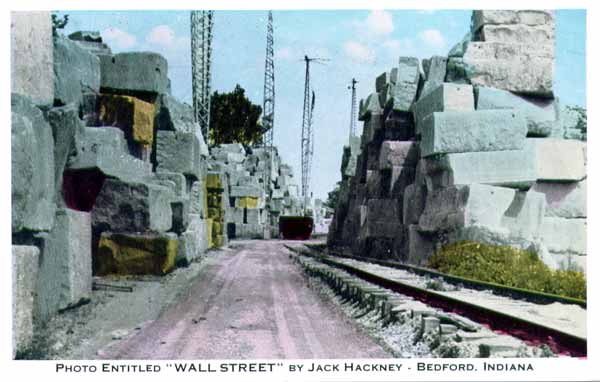
Postcard of a photo entitled "Wall Street" by Jack Hackney - Bedford, Indiana
The text on the postcard says "From these blocks come the finished products. Indiana limestone is the nation's building stone and is used for constructing skyscrapers, schools, churches and private homes."
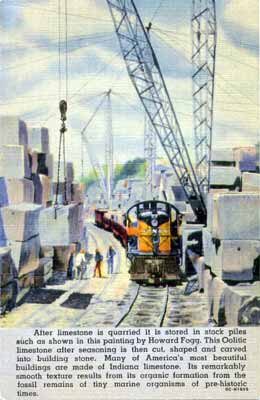
Indiana limestone quarry by Howard Fogg
The text on the postcard says "After limestone is quarried it is stored in stock piles such as shown in this painting by Howard Fogg. This Oolitic limestone after seasoning is then cut, shaped and carved into building stone. Many of America's most beautiful buildings are made of Indiana limestone. Its remarkably smooth texture results from its organic formation from the fossil remains of tiny marine organisms of pre-historic times."
The seasoning is required because the limestone decompresses as it is quarried and can also contains ground water. Buff limestone requires 60 - 90 days to season but grey limestone requires at least 6 months.
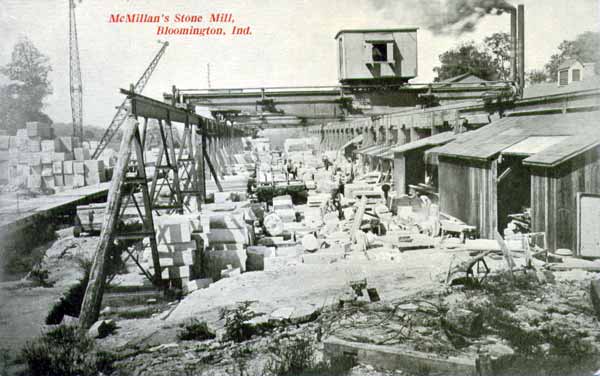
McMillan's Stone Mill, Bloomington, Indiana
The text on the postcard says "One of the 38 mills and cutting plants which the Indiana Limestone Company has at Bedford and Bloomington, Indiana, for cutting "The Nation's Building Stone" and preparing it for erection in the buildings that are constructed of this material."
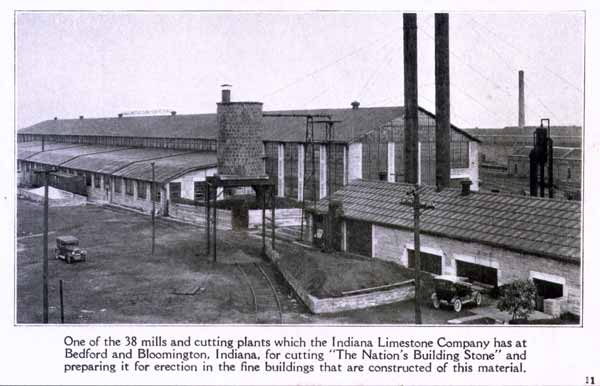
Indiana Limestone Company, Bedford
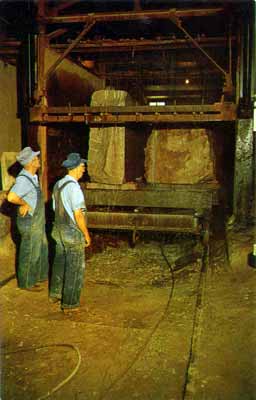
Indiana Limestone Company, Bedford
The text on the postcard says "This scene is inside the Joiner Mill, of the Indiana Limestone Company, the largest limestone company in the world. The gang saws are sawing a huge block of limestone for custom or veneer use. These large blocks may weigh as much as 25 tons. The jets of water wash out the slush that accumulates. The two men are seeing that everything is working smoothly."
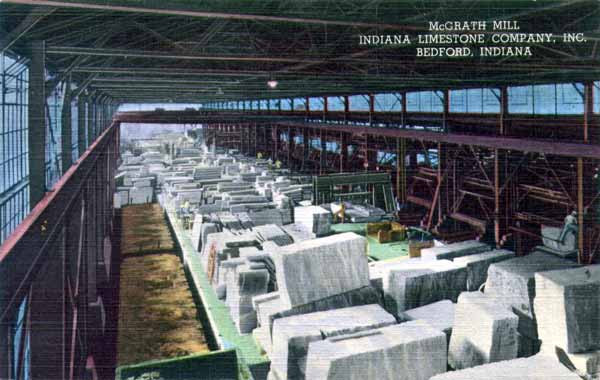
McGrath Mill, Indiana Limestone Company, Bedford, Indiana
The McGrath Mill is one of the many mills
operated by the Indiana Limestone Company
for the cutting and fabricating of Limestone.
The most modern milling equipment in the
world prepares the nation's building stone
for use in constructions including slyscrapers,
schools, churches and private homes. Artistic
and beautiful statues are also hand-carved
here.
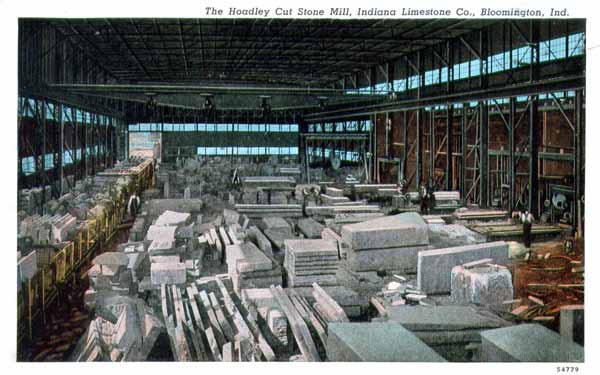
Hoadley Cut Stone Mill, Indiana Limestone Company, Bloomington
There were several people named hoadley who owned stone mills in Indiana. The following are extracts from the Gazetteer of Limestone Mills
There were two mills of the J. Hoadley and Sons Company on the south edge of Stinesville that were built sometime prior to 1896. The one on the west of the railroad was the larger of the two and burned in about 1916. After the fire the company left Stinesville and moved its milling operation to Bloomington where it built the Tribune Mill. The stone for the Tribune Building in Chicago came from this mill . It was located just south of Grimes lane and on the east side of the railroad tracks. It was gone by the 1940's and nothing remains of it
The Bloomington Cut Stone Cmpany built a mill in 1906. John Hoadley of the Hoadley Stone Cmpany bought it in about 1914 or 1915 and doubled its size. From then until the merger in 1926 it was Mill B of the Hoadley Stone Company. After the merger it was the Bloomington Mill of the Indiana Limestone Company. It was razed sometime in the 1940's and nothing remains. It was located midway between First and Dodds Streets and ran in an east and west direction with the west end along the Monon tracks.
A large mill was located just north of Grimes Lane and east of the railroad tracks. John W. Hoadley, Jr. built this mill in 1906. His company was the Hoadley Stone Company and is not to be confused with the J. Hoadley & Sons Company who built the Tribune M i l l across Grimes Lane to the south. After the merger the Mill A of the Hoadley Stone Company was called the Hoadley Mill and later the Indiana Mill of the Indiana Limestone Company. It was gone by the early 1940's and nothing remains at the site.
The Hoadley-Cline Stone Company Mill was another mill that had to have been built sometime between 1913 and 1927. Kenneth Cline and Ellsworth Hoadley built it. Their company was one of those that merged in 1927 to become the Bloomington Limestone Company. (This is not to be confused with the much larger merger the year before that formed the giant Indiana Limestone Company.) The mill was located about midway between Walnut and Morton Streets and was on the north side of Allen Street. It is no longer there.
John Hoadley. Jr. built a four gang mill about 1923. His company was one that merged in 1926 and afterward the Indiana Limestone Company added two gangs and named the mill the Wicks Mill. It was shut down in about 1930. It was due north of the Crescent Mill and, at least until 1950, some foundations could be seen about forty yards due west of the junction of new Highway 37 and the Highway 46 bypass north around Bloomington.
The mill of the Sare-Hoadley Stone Company was built sometime during the 1920's. In the 1950's the building was removed and utilized to expand the mill of the new Woolery Stone Company Mill. In the 1990's a few foundations can be seen along the north side of the Smithville Road just west of the Smithville Telephone Company building.
The B. G. Hoadley Quarries Company Mill was built in 1928 and in 1950 was still in the business of milling limestone.
J. Mason Hoadley built a mill in 1930. It is still there in 1950 but by 1969 was no longer a stone mill . It was located on the west side of Highway 37 south of the site of the Mutual Oolitic Stone Company Mill. The Bloomington Telephone, March 29, 1930 edition carried this article...
J. Mason Hoadley in association with J.W. Hoadley announces the building of a $150,000 cut stone company to be located in the belt east of the Monon yards on the Dixie. The new mill, 164 by 150 feet, is known as J. Mason Hoadley, Incorporated, with 10,000 shares of stock, no par value.
We believe in the future of cut stone in Bloomington or we would not build at a time when some mills are not running, said J. Mason Hoadley in speaking of the plans for the new building.
Comparing in size with the Hoadley-Cline company and the Bloomington mill of the Indiana Limestone company the new mill will be fire-proof throughout with galvanized siding and highest grade asbestos roofing. The mill will employ 45 to 50 men with the following equipment: 5 planers, 2 gang saws, 3 diamond saws, 2 travelers, and 2 tramways with covered leanto.
The name Hoadley has long been associated with stone in the belt. J.W. Hoadley, Sr. began operation at Stinesville after the civil war about 1880. After a disastrous fire the Hoadley Stone company was formed in Bloomington in 1903. The present J.W. Hoadley carried on the business of his father in Bloomington and later in association with his son, J. Mason Hoadley, built up a large and profitable business. J. Mason Hoadley was associated with his father for about 10 years before and after the world war as general manager of the Hoadley Stone company. In 1926 the Hoadley stone company was sold to the Indiana Limestone company and J. Mason Hoadley became superintendent of the Hoadley mill of the Indiana Limestone company for two years. He then left the stone business and re-entered as part owner of one of the larger cut stome mills of the belt.
Buskirk and Dodds were awarded the contract for laying the foundation of the new mill. The Bedford Foundry and Machine company received the structural contract and Seward and company will install an Ingersol-Rand air compressor. Work has already begum on the new cut stone mill.
The Perry Brothers firm became the Perry Stone Company after Henry retired in 1896 and Gilbert Perry died in 1898. About 1940 William Hoadley bought the Perry Stone Company, which was in receivership. A few years later William McNeely bought the mill from William Hoadley.
It must have been a slow news week for the Bloomington Evening Weekly, January 29th, 1917 edition which carried this story on the front page...
At ten o'clock last Saturday night fire was discovered in the tool room of the Hoadley Stone Mill on south Morton street. The fire department made a quick run and soon had the blaze under control. The damage would not be more than $15. Origin of the fire is unknown.
B. G. Hoadley Quarries was incorporated in 1926 but traces its roots to the earlier Hoadley companies starting around 1880.
Sources:
B. G. Hoadley Quarries
Gazetteer of Limestone Mills
RootsWeb: INMONROE-L Archives
RootsWeb: INMONROE-L Archives
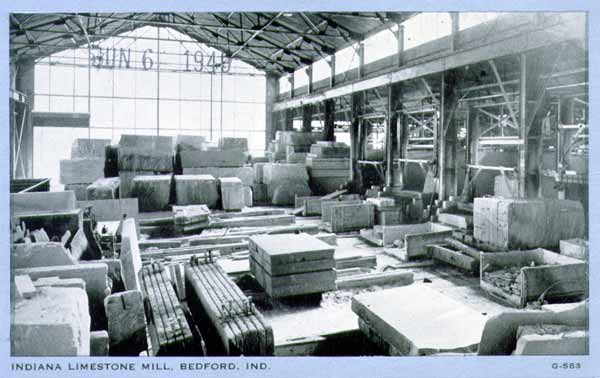
Indiana Limestone Mill, Bedford, Indiana
This postcard is stamped June 6th, 1949.
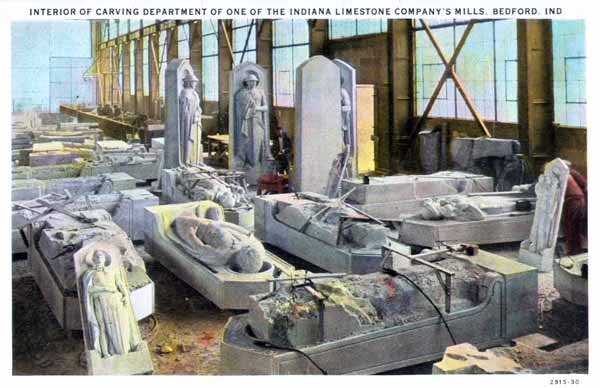
Interior of Carving Department, Indiana Limestone Company Mill, Bedford, Indiana
This unused postcard has the printed text...
2915-30
Made by Curt Teich & Co., Inc., Chicago, U. S. A.
Curt Teich, Chicago trademark logo
This page created 28th January 2009, last modified 31st March 2010